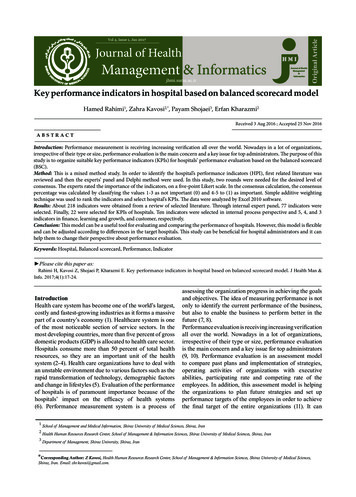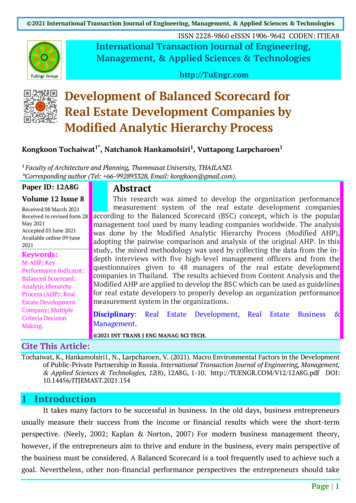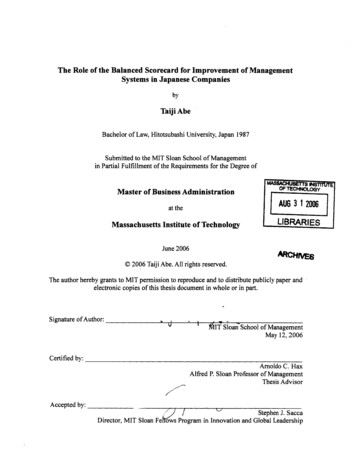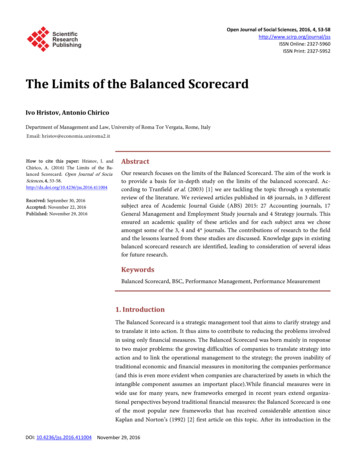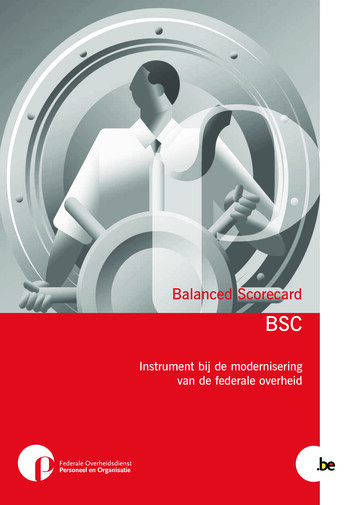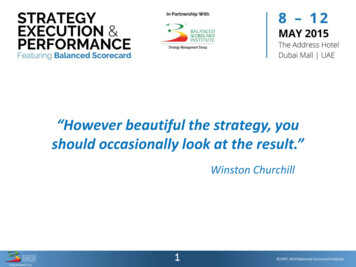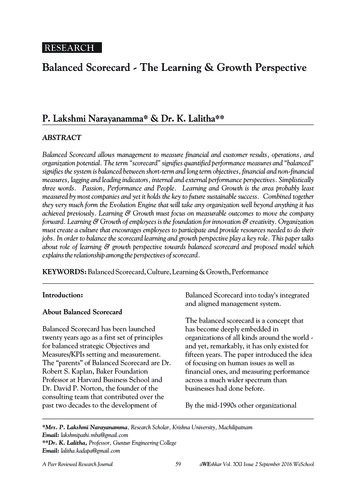
Transcription
RESEARCHBalanced Scorecard - The Learning & Growth PerspectiveP. Lakshmi Narayanamma* & Dr. K. Lalitha**ABSTRACTBalanced Scorecard allows management to measure financial and customer results, operations, andorganization potential. The term “scorecard” signifies quantified performance measures and “balanced”signifies the system is balanced between short-term and long term objectives, financial and non-financialmeasures, lagging and leading indicators, internal and external performance perspectives. Simplisticallythree words. Passion, Performance and People. Learning and Growth is the area probably leastmeasured by most companies and yet it holds the key to future sustainable success. Combined togetherthey very much form the Evolution Engine that will take any organization well beyond anything it hasachieved previously. Learning & Growth must focus on measurable outcomes to move the companyforward. Learning & Growth of employees is the foundation for innovation & creativity. Organizationmust create a culture that encourages employees to participate and provide resources needed to do theirjobs. In order to balance the scorecard learning and growth perspective play a key role. This paper talksabout role of learning & growth perspective towards balanced scorecard and proposed model whichexplains the relationship among the perspectives of scorecard.KEYWORDS: Balanced Scorecard, Culture, Learning & Growth, PerformanceIntroduction:Balanced Scorecard into today's integratedand aligned management system.About Balanced ScorecardThe balanced scorecard is a concept thathas become deeply embedded inorganizations of all kinds around the world and yet, remarkably, it has only existed forfifteen years. The paper introduced the ideaof focusing on human issues as well asfinancial ones, and measuring performanceacross a much wider spectrum thanbusinesses had done before.Balanced Scorecard has been launchedtwenty years ago as a first set of principlesfor balanced strategic Objectives andMeasures/KPIs setting and measurement.The “parents” of Balanced Scorecard are Dr.Robert S. Kaplan, Baker FoundationProfessor at Harvard Business School andDr. David P. Norton, the founder of theconsulting team that contributed over thepast two decades to the development ofBy the mid-1990s other organizational*Mrs. P. Lakshmi Narayanamma, Research Scholar, Krishna University, MachilipatnamEmail: lakshmipathi.mba@gmail.com**Dr. K. Lalitha, Professor, Guntur Engineering CollegeEmail: lalitha.kadapa@gmail.comA Peer Reviewed Research Journal59aWEshkar Vol. XXI Issue 2 September 2016 WeSchool
Balanced Scorecard - The Learning & Growth PerspectiveElectric on performance measurementreporting in the 1950's and the work ofFrench process engineers (who created theTableau de Bord – literally, a "dashboard"of performance measures) in the early partof the 20th century.theorists had taken up Kaplan and Norton'swork and modified the design method ofbalanced scorecards, ironing out early flaws.The idea of three generations of balancedscorecards was built on in Cobbold andLawrie's work of 2002, which described howthe balanced scorecard - or BSC, as it isoften referred to - can support three distinctmanagement activities and has evolved intothe use of strategy maps as a strategicmanagement tool. It has given a balancedview about the performance metrics.Starting from the day of its birth much ofthe research went on Balanced Scorecard.But, the research is of conceptual in nature.Recently many companies started designingtheir own scorecard with differentperspectives. BSC implementation is anoverall approach where collective effort isrequired from all levels of the organization.It requires in-depth analysis, planning &commitment from people.BSC has evolved from its early use as asimple performance measurementframework to a full strategic planning andmanagement system. The “new” balancedscorecard transforms an organization'sstrategic plan from an attractive but passivedocument into the "marching orders" forthe organization on a daily basis. It providesa framework that not only providesperformance measurements, but helpsplanners identify what should be done andmeasured. It enables executives to trulyexecute their strategies.This new approach to strategicmanagement was first detailed in a series ofarticles and books by Drs. Kaplan andNorton. Recognizing some of theweaknesses and vagueness of previousmanagement approaches, the balancedscorecard approach provides a clearprescription as to what companies shouldmeasure in order to 'balance' the financialperspective. The balanced scorecard is amanagement system (not only ameasurement system) that enablesorganizations to clarify their vision andstrategy and translate them into action. Itprovides feedback around both the internalbusiness processes and external outcomes inorder to continuously improve strategicperformance and results. When fullydeployed, the balanced scorecard transformsstrategic planning from an academicexercise into the nerve center of anenterprise.Balanced Scorecard is a strategic planningand management system that is usedextensively in business and industry,government, and nonprofit organizationsworldwide to align business activities to thevision and strategy of the organization,improve internal and externalcommunications, and monitor organizationperformance against strategic goals. It wasoriginated by Drs. Robert Kaplan (HarvardBusiness School) and David Norton as aperformance measurement framework thatadded strategic non-financial performancemeasures to traditional financial metrics togive managers and executives a more'balanced' view of organizationalperformance. While the phrase balancedscorecard was coined in the early 1990s, theroots of the this type of approach are deep,and include the pioneering work of GeneralA Peer Reviewed Research Journal60aWEshkar Vol. XXI Issue 2 September 2016 WeSchool
Balanced Scorecard - The Learning & Growth PerspectivePrevious Targets“To achieve ourvision, how willwe sustain ourability to changeand improve?”“To satisfy ourshareholdersand customers,what businessprocesses mustwe excel at?InitiativesObjectivesLearning andGrowthhuman into tangible commercial assets,then author said that the learning-andgrowth dimension of strategy has so far onlybeen scratched on the surface, that is,statistically. The tip of the invertedpyramid suggested by the balancedscorecard framework, which centrallycomprises, at its tip, the intangible assets ofpersonnel mental growth over the life span,has so far not been thoroughly eitherassessed or consciously activated bymanagement. As a result, companies'knowledge about their intangible mentalgrowth assets is shallow, and their controlover intangible human resources iscorrespondingly weak. But “intangible” is a[1] Authors coated that the traditionalistenablers of learning and growth in thebalanced scorecard framework (BSC) areinsufficient for “driving down” strategy sothat the authors introduced into BSC anadditional tier of “meta-enablers” forlearning and growth. Meta-enablers aremental-growth competencies that groundand enable the traditionalist enablers, suchas employee satisfaction, productivity, andretention (staff competency, use of strategictechnology, climate for action). Ifeconomic value creation is the translation,through focused strategy, of intangibleA Peer Reviewed Research JournalInternal nitiatives“To achieve ourvision, how shouldwe appear toour customers?”ObjectivesCustomerMeasures“To succeedfinancially, howshould weappear to easuressuccess. These financial measures areinadequate, however, for guiding andevaluating the journey that information agecompanies must make to create future valuethrough investment in customers, suppliers,employees, processes, technology, andinnovation."Kaplan and Norton describe the innovationof the balanced scorecard as follows:"Balanced Scorecard retains traditionalfinancial measures. But financial measurestell the story of past events, an adequatestory for industrial age companies for whichinvestments in long-term capabilities andcustomer relationships were not critical for61aWEshkar Vol. XXI Issue 2 September 2016 WeSchool
Balanced Scorecard - The Learning & Growth Perspectiveknowledge management. The author camewith a new view to BSC and shown thefifth perspective of BSC - the technologicalperspective, which is included inperspective of learning and growth andessentially provides the infrastructure toachieve the objectives of other perspectivesof BSC and corresponds with theknowledge management technologieswithin the enterprise.relative term. Its meaning depends on howmuch of what is invisible can be madevisible. Through Corporate DevelopmentReadiness and Effectiveness Measure(CDREM) intangible mental-growth assetsare made visible, and then tangible, asnever before.[2] Organizations have realized thatlearning is more than training. They havebroadened their understanding of learningto include the development of corporateculture, the strength of knowledgemanagement, the importance of focusingtraining funds and the inherent value ofinformal networks. Most of all they havelearned to align learning initiatives tobusiness objectives and make profoundchanges to those that do not fit.[3] Learning & Growth Perspective focuseson the intangible assets of an organization,mainly on the internal skills andcapabilities of the employees that arerequired to support the value-creatinginternal processes. The Learning & GrowthPerspective focuses on Human, Information& Organization Capital. The Learning andGrowth objectives describe how the people,technology, and organizational climatecombine to support strategy. Measures inthis perspective are lead indicators forimprovements in the internal processes,customer and financial perspectives.[5] The most important perspective insidethe BSC is learning and growth perspectivethat have significant relationship with thedevelopment of human capital in theorganization. This paper attempts tofacilitate communication andunderstanding of business goals andstrategies at all levels in the organization.Rather than that, organization attempt todevelop skills through education andtraining, motivated employees, provideaccess to strategic information, alignindividuals and teams to business unitobjectives. By using balanced measures atthe organizational level, and by sharing theresults with supervisors, teams, andemployees, managers are providing theinformation needed to align employeeperformance plans with organizationalgoals. At the same time, by balancing themeasures used in employee performanceplans, the performance picture becomescomplete.[4] Eva Rakovska (2011) stated that manychanges of business environment comefrom changes of management. New aspectsof business performance are associated withnew concepts of measurement. The BSCconcept is a good platform for building newframe for measure the business performancealso in knowledge economy, because here isa similar approach for implementing[6] Capelli and Crocker-Heffter haveresearched on the correlation betweenhuman resources practices and the strategythe company adopts, reaching down “to thespecific practices, and their effectiveness forthe development of the organization indefined strategies”. Starting from thisauthor, this paper reviews the BSC as a toolfor aligning human capital with businessA Peer Reviewed Research Journal62aWEshkar Vol. XXI Issue 2 September 2016 WeSchool
Balanced Scorecard - The Learning & Growth Perspectiveof shareholders satisfaction, ROI etc. Inorder to achieve this company must dealwith people in such a way whereorganizational objectives need to bematched with individual objectives whichin turn increase the financial status of theorganization. Also the goals of anorganization need to be transparent. Thiscan be possible my maintaining dashboardswhich consist of key decision areas and ifany discrepancy arises dashboards will helpin achieving them.processes through human resourcespractices. HR practices that align processesand human capital are specific to the valuesof those processes and, therefore, to thestrategy they serve, this alignment results inlabour values, or specific labour climate.Proposed model of learning & growthperspectiveIn a "knowledge economy", the intangibleresources are significant resources that addvalue to company's growth. Since the mostbusiness processes are viewed throughknowledge management, the realchallenge, therefore, is developing anadequate system of knowledge managementin companies. Satisfied employees areprecondition for increasing productivity,responsiveness, Quality and Customerservice. The knowledge transfer tobalanced scorecard is through learning &growth perspective which requires itsattention starting from employeerecruitment, training, involve, engage andretain them through continuousmonitoring. To increase and maintain thevalue of intellectual capital, companiesinvest in education and continual trainingof its personnel, establish a system ofgrading employees and their performance,reward and promote quality staff. The keystrategic theme is the need to re-skill orupgrades the skills of the scenarioworkforce in order to achieve the vision.Below model shows the role of learning &growth perspective towards achievement ofother perspectives of balanced scorecard.Table 1 about here:Step 2: Customer PerspectiveFocus on orientation on the customer,because employees are tightly in touch withthe customers e. g. deal with customercomplaints, provide good customer serviceand information. Employees should alwaysresolve problems quickly, efficiently and atthe heart of customer service process.Step 3: Internal Business PerspectiveThe Internal Process Perspective focuses onall the activities and key processes requiredin order for the company to excel atproviding the value expected by thecustomers. Internal Processes are leadindicators where management interventionis possible to affect customer and financialoutcomes. Managers identify the processesthat are most critical for achievingcustomer and shareholder objectives.Companies typically develop theirobjectives and measures for this perspectiveafter formulating objectives and measuresfor the financial and customer perspectives.Performing the same operations over andover with the same level of efficiency andproductivity is no longer enough. Bycontrast, the company must undertakecontinuous improvement plans and, moreStep 1: Financial PerspectiveWhen we talk about financial perspectiveof balanced scorecard it is not only a matterA Peer Reviewed Research Journal63aWEshkar Vol. XXI Issue 2 September 2016 WeSchool
Balanced Scorecard - The Learning & Growth Perspectiveimportant, extent the concept ofcontinuous improvement in the internalprocesses and towards the customers. Talent Identification Talent Development Talent DeploymentStep 4: Learning & Growth PerspectiveThis perspective serves to map some biglearning goals; something that is relevant tothe current business challenges. Having aseparate learning perspective doesn't meanthat the company should stop otherlearning processes; on the contrary, thisperspective just works as a compass to focuson the most important learning efforts.Regular insights, improvements andlearning should still be implemented ineach business iteration.In other words, in this perspective weshould explain what the company has tolearn in order to: Satisfy customer's needs, Improve business processes, and Achieve financial goals.Talent IdentificationThe cornerstone to an organization'sgrowth from within strategy isidentification of high-potential talent.Having a strong pipeline of high-potentialtalent is vital to organizations because itbuilds an organization's competitiveadvantage for the future (Snipes, 2005). Intoday's rocky economic environment,identifying and attracting high-potentialemployees can give employers an edge ontheir competition and set up theirorganizations for future success.Talent DevelopmentIn today's difficult economic times,employers enjoy the apparent luxury ofhaving many people to choose from everytime they advertise a job. The reality is,however, that few of these candidates willhave the proven skills required to matchthe opening for which they are applying.Concentrating on the talent and skills ofexisting employees also helps raise staffmorale. If employees see that there areopportunities for career flexibility andadvancement, they are more likely to feelpositive about their career prospects intheir current job. However, if businesses areto develop internal talent successfully, theyfirst need to ensure that they focus onretaining their best employees.Learning and growth perspectives is a stageby stage process where organization need totake into consideration employees opinionsabout the company and their requirementswhich helps in retaining the employeesalong with engagement and commitment.In today's competitive world the role of HRbecame strategic. Following traditionalpractices like recruitment and selection wasgone and HR became a strategic partnerwhere he too had a seat in board roomdiscussions about organizational activities.In future HRM departments may be calledas Talent Management department as theneed for talent is on rise. Let us discussabout talent management process in detailswhich in turn become a lead indictortowards growth of organization in achievingboth customer and financial objectives.A Peer Reviewed Research JournalTalent DeploymentRecent management philosophy has shownan increasing realization of the importanceof customer focus and customer retention.These are leading indicators. Poor64aWEshkar Vol. XXI Issue 2 September 2016 WeSchool
Balanced Scorecard - The Learning & Growth Perspectiveadaptability skills and place them in keyroles wherever they are required.performance from this perspective is thus aleading indicator of future decline, eventthough the current financial picture maylook good. Customer delight and loyaltycan be built only through talentedemployees because happy, committed andmotivated employees pass on their goodwillto the customers like a true partner.Therefore organizations must value andrespect its talent to build and sustaincustomer base. This requires a talentedemployees extending strategic support tothe customers.Conclusion:A company needs well-trained, highlyskilled employees if it is to excel in the firstthree strategic perspectives. Educationalgoals drive the attainment of other strategicobjectives. Invest in human capital byspending money on employee capabilities,information/knowledge systems andmotivation, empowerment and alignment.These factors can be measured by assessingemployee satisfaction, skills andproductivity. Other possible measuresinclude productivity levels, training andskill levels, performance improvement andindividual performance goals that alignwith the objectives of the Balanced Scorecard (BSC).The above suggested model willreally be helpful to overcome the problem.When comes to implementation of BSCorganizations need to be very cautious as weall know that it is not a single stepprocedure.Talent RetentionAs we all know that customer is the godand he is the decision maker in the marketand became the ultimate goal of companies.But it doesn't mean that top priority mustbe given to them by neglecting theremaining stakeholders. Until and unlessproper work culture is maintained peoplewill not react to the situation positively. Ifyou want to satisfy the god (customer) thefirst person before him is the priest (i.e.employee). Organizations need to havetheir attention on employee retention bysatisfying them with all means whichdirectly leads to customer satisfaction.ReferencesErik Finch (2010) A talent developmentapproach that integrates learning andperformance management is needed toretain staff, MAY 04,Due to constant changes in both internalenvironment factors like organizationstructure, culture, climate, expansion ofbusiness & work force diversity, etc &external environment factors like social,economical, political, technological, legalaspects day by day organizations are facingmany challenges and opportunities whichdirectly or indirectly affect the business. Inorder to face them organizations need toidentify the key personnel who have thecapability of facing the challenges anddevelop them with good decision making,A Peer Reviewed Research JournalEva Rakovska (2011) Technologicalperspective - extension of the Learning andGrowth Balanced Scorecard, University ofEconomics in Bratislava, SlovakiaLearning & Growth Perspective,http://www.theclci.com/products PMMSBSC04.htm65aWEshkar Vol. XXI Issue 2 September 2016 WeSchool
Balanced Scorecard - The Learning & Growth PerspectiveOtto Laske (2001) A learning-and-growthmetric for strategy-focused organizations,PhD PsyD, Personnel DevelopmentConsultation, Oelaske @earthlink.net,Copyright Otto Laske, http:// www.balanced score card. org/ wpapers.htmlSnipes, J. (2005) Identifying andcultivating high-potential employees. ChiefLearning Officer. Retrieved fromhttp://clomedia.com/articles/view/identifying and cultivating high potential employees/2P. Capelli, A. Crocker-Heffter (1996)Distinctive human resources are firm's corecompetences. Organizational Dynamics,7–22.Tapomoy Deb, A Conceptual Approach toStrategic Talent Management, IndusPublishing Company.The Balanced Scorecard: A d%20Scorecard/the balanced scorecard a learning perspectiveRob, (2011) Balanced Scorecard – Whatwould you include in the Learning &Growth Perspective? http://www.inspiredchange.co.uk/2011/04/balanced score cardwhat-would-you-include-in the -learninggrowth-perspective/Chart 1 : Talent Management: An antecedent to Balanced ING & GROWTHPERSPECTIVETALENT MANAGEMENTDeploymentA Peer Reviewed Research Journal66RetentionaWEshkar Vol. XXI Issue 2 September 2016 WeSchool
Copyright of Aweshkar Research Journal is the property of Prin. Welingkar Institute ofManagement Development & Research and its content may not be copied or emailed tomultiple sites or posted to a listserv without the copyright holder's express written permission.However, users may print, download, or email articles for individual use.
KEYWORDS: Balanced Scorecard, Culture, Learning & Growth, Performance Introduction: About Balanced Scorecard Balanced Scorecard has been launched twenty years ago as a first set of principles for balanced strategic Objectives and Measures/KPIs setting and measurement. The "parents" of Balanced Scorecard are Dr. Robert S. Kaplan, Baker .





